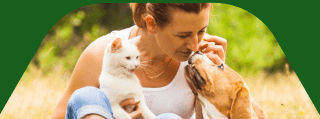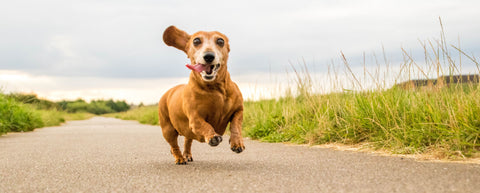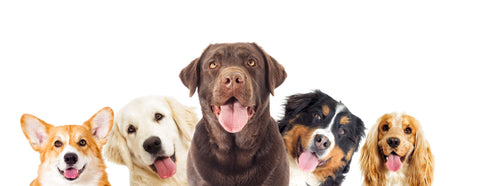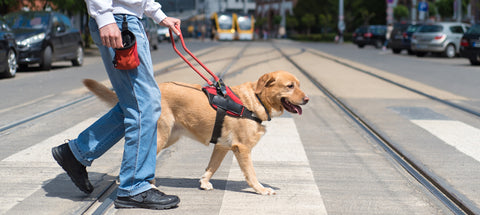Are we seeing more signs of separation anxiety in dogs since the pandemic? No one could have predicted the astounding events that have taken place. A global pandemic and a host of other events and changes in the world have left us all feeling a little wide-eyed - including our dogs.
And as much as we’re feeling it – our canine companions can feel the effects of all this change too. We’ve leant on them in our difficult times and they've been by our sides more than ever. And while they can't tell us exactly how they're feeling, there are some key ways to spot anxiety in dogs.

What are the causes and signs of anxiety in dogs?
Anxiety in dogs is very common. There are lots of things that can cause anxiety in our pooches. Whether it’s the mailman or kites, hot air balloons or other dogs - most of our pups can find life stressful from time to time. It’s not just since COVID. Do you think you can spot the signs of an anxious dog – and do you know what to do to help?
What is fear and anxiety in dogs?
All animals feel fear - including us humans. It’s called a primal instinct, and flares up as a reaction to real and perceived fears. When an animal spots or hears a ‘danger’, their brain signals fear, and the fight, flight or freeze response is triggered. The important bit here though is perception. The fear response that’s saved our (human and doggie!) ancestor’s skins time and time again can also be triggered in situations that aren't actually dangerous at all – our dogs just perceive danger. And that’s the key.

The types of anxiety in dogs
Broadly speaking, there are 4 different kinds of fear and anxiety in dogs:
- Instinctive fear response – another dog might lunge, bark or maybe growls at your dog which they instinctively find the situation to be scary.
- Learned fear response – a child on a scooter accidentally bumps into your dog at the park. Your dog learns that children, scooters and/or the park might be dangerous. They become fearful and anxious in the park; around scooters; and/or around children
- Phobias – this is where your dog develops a long-lasting, extreme fear of something very specific. This can be of something seemingly random – fireworks, balloons, men with hats – or a learned fear response that has escalated after repeated exposure to something they find scary (other dogs, strangers, travel… even children on scooters in parks!)
- Anxiety in older dogs – as our furry friends near retirement, they can become more timid and anxious. Some older dogs also develop a kind of doggie dementia known as Canine Cognitive Dysfunction (CCD) – if your elderly dog becomes anxious or fearful or forgetful and confused, always talk to your vet.
What are the signs of an anxious dog?
There are some obvious signs of anxiety and some more subtle signs of anxiety in dogs – here’s a helpful rundown to help you identify them:
The obvious signs of anxiety in dogs
- Hiding
- Shaking or cowering
Most of us know already that things like tucking their tail under their belly; shaking, crying, whining and trembling are all signs of anxiety in dogs. Dogs will avoid the scary thing by backing away, turning away, hiding or running. Some fearful or anxious dogs will become more clingy and cuddly, while others will seem restless and will find it hard to settle.
The subtle signs of anxiety in dogs
- Licking their lips
- Yawning
You might see your dog doing something that seems out of context if they're worried or scared… perhaps they’re yawning, sniffing the ground, licking their lips or 'shaking-off' – having a shake like they do when wet? If this seems to happen after coming into contact with something (or someone) regularly, it could be a sign of anxiety. These odd activities are known as 'displacement behaviors' and are your dog's way of finding a coping mechanism when they're uncomfortable and not sure what to do.
The surprising signs of anxiety in dogs
- Bearing teeth or growling
- Destructive or creating accidents
Think you've got a naughty dog? They're more likely to be a very upset, fearful. misunderstood, anxious dog. Some behaviors in anxious dogs are traditionally viewed as ‘bad behavior’. So if your dog is barking a lot, being destructive, having accidents in the house, growling or biting, don't punish them – it’s likely they're very fearful or anxious. Instead, get help. These are the more serious signs of fear and anxiety, and ask for a behavioral expert’s support ASAP.

Common Triggers
So now you know what to watch out for, when do you need to look for these signs? Let’s take a closer look at the common triggers of anxiety in dogs:
Change in their routine
Dogs, a bit like us – are creatures of habit. They find comfort in routine – doing similar things at similar times. And changes to this can unsettle them. Since the pandemic they (as well as us!) have had to cope with a whole host of differences to our normal everyday lives.
From being at home more to seeing friends and family less, our routines and way of life has changed. And our furry friends can be unsettled by this.
Stranger danger
Some dogs can find other dogs stressful. This can be down to a lack of socialization when they were younger or maybe as a result of bad experiences. Another common trigger is strange people. That can vary from the mailman and people passing by or visiting your home, through to old friends who look or behave differently, or have a distinctive features like hats, beards or uniforms.
Separation anxiety
The bond between dogs and their favorite people can be very strong, and many dogs show signs of anxiousness when home alone. Behaviorists fear that more dogs than we might guess suffer in silence too – unless we rig up a webcam, it’s hard to know what happens when our pooches are home alone. Many dogs become fearful or anxious if a trip to the kennels is on the cards too.
Transport, movement and vehicles
It’s not surprising that our dogs can find travelling a bit scary – jumping in a metal box to move really quickly is a bit strange! Fears and anxiety often start with motion sickness or not enough socialization and habituation as a pup, but can follow bad experiences too. As well as cars and public transportation, other common motion-related fears include humans moving in unusual ways – people running, cycling or skateboarding.
Newness
Though many dogs are naturally outgoing and curious, some find things that are new and different scary. In practice, that might mean the terrifying decor that’s invaded the street, an evil new sign outside a shop, or even holidays where they’re encountering situations or places they haven't experienced before.
Children and new family members
Unfortunately, our best friends don't always welcome new arrivals – that might be a new baby joining the family, or new pets! Older kids can be scary too, as they are less predictable than adults, tend to move more quickly and make more noise.
Loud noises can be an issue too. We're talking the classic firework fears many of our dogs experience, through to the hated vacuum, sirens and even loud music!
Vets and grooming
As we mentioned, dogs can learn to find things scary, so even if you’ve socialized your pup very carefully, a ‘nasty’ trip to the vet or groomer can change their perception. It is possible to work on rebuilding more positive associations.

How can you help your anxious dog?
Doggie fears are individual, so there’s no one-size-fits all fix. But thankfully, there are ways to work with your dog to overcome their fears and anxieties. Techniques called desensitization and counterconditioning can be used as part of a therapy plan if something has already become scary – but it’s important to talk to dog experts before beginning this kind of work.
Do I need to talk to my vet?
Once you've recognized that there is something worrying your dog, it’s a good idea to visit your vet and check that everything’s OK medically. If whatever is bothering your best friend isn’t medical, the next step is finding an dog expert who can set out a practical plan to help you and your dog work together to manage and improve the situation together.
Finding the right behaviorist
When it comes to working with fearful or anxious dogs, we always recommend finding a fully certified dog behaviorist.
Out-of-date advice can actually do a lot more harm than good to your dog’s behavior and welfare. So it’s really important to do your homework when you're seeking behavioral advice.
Can supplements help stressed, fearful and anxious dogs?
Yes – in conjunction with expert advice. Supplements can make a difference by supporting natural calming pathways in the brain. It’s a great way to speed up and support your behavior modification efforts.
Does your dog get anxious? How do you help them cope with scary situations? Can you share your dogs success story to inspire other pet parents who’re working with anxious or fearful dogs? We love to hear what’s happening with your dogs, so why not leave a comment below.
Recommended Product
If your dog is struggling to cope with their anxiety or stress, the YuCALM Soft Chews can help your pup maintain calmness.











